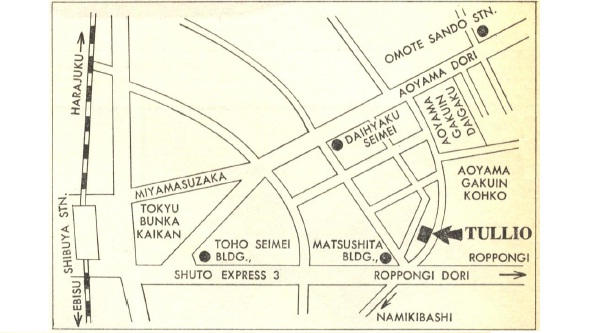Don’t all go rushing to Tullio after reading this column. For it’s a tiny place — perhaps “cozy” or “intimate” would be a better adjective — and, in an emergency, can seat 20, but then it would be bursting at the seams. So make a reservation by calling 400-6062 or 6786.
Though the space is tiny, the taste is great. That is the judgment of three of us, the other two being epicures for whose discriminating palates I have high respect. I remember especially a spicy arrabbiata sauce so smooth that, though it came on strong, did not offend the heat sensors of our tongues. But more of that later.
I had heard of the Italian restaurant from a friend who had heard about it from a friend. The second-hand description was so clothed in praise that my curiosity was pricked. I called my gourmet friends, gave them a summation of what I was told, and they were in.
Tullio is not far from Roppongi-dori, but we got there by driving up Route 246 toward Shibuya and taking the first left after passing Aoyama Gakuin. We had almost reached Roppongi-dori before we saw the restaurant sign prominently displayed from the Kinsei Building.
When we entered the restaurant, in the basement, we were greeted by an austere decor: the upper half of the wall and the ceiling a creamy white; lower half a brown. Later we decided there was a reason for the simplicity: the decor does not distract you from the marvelous food.
We devised a way whereby we could triple the dishes we tasted. Each of us would order a different antipasta, pasta and main dish and have them served Chinese fashion: plate by plate, with each of us getting our share of each.
First dish was Sarde in Tortiera or sardines with garlic, 1,000 yen. They had been breaded to absorb the flavor of the butter and olive oil in which they had been fried. The combination of flavors thus obtained gave it a unanimous grade of A. But then came Seppie in Arrabbiata or squid in arrabbiata sauce, 1,400 yen. The squid, cooked to the limit of tenderness a squid can achieve, left us worldless. How can one do verbal justice to a flavor? What we could do, though, was give it a strong A and downgrade the sardines to B plus.
Third entry was Datteri al grate, 1,400 yen. Datteri is a shellfish I have eaten in Venice and nowhere else until Tullio. It also had been breaded and fried in butter, the combinations of flavors getting it an A minus.
Now came the first of the pastas, Spaghetti Alla Arrabbiata, 1,200 yen. The spaghetti was a perfect al dente. With the spiced-up tomato sauce, it gained an A. Next was Fettucine alla Bolognese or fettucine in Bolognese sauce, 1,500 yen. Because the sauce was so good, we decided to play the Guess What’s In It game. I was first. The rich, creamy flavor with a slight tang told me that there was cream and Parmesan cheese in it. I also detected garlic and onion.
The second player agreed with me, but said he also tasted carrot. The third added celery. Celery? How did he detect that? In the slight touch of sweetness, he said. The presence of meat and wine was too obvious to mention. We called the chef, and he confirmed the onion, garlic, carrot, celery, cream, Parmesan cheese, meat and wine but added bouillion, which we had missed. We were puzzled at first how to grade the dish, but finally settled on an A minus.
The last of the second course was Risotto alla Funghi or rice with mushrooms, 1,500 yen. This even exceeded the excellence of the squid. It was made with fresh cream, Parmesan cheese and cooked in butter. I had never before tasted such delicious risotto (I usually avoid risottos in favour of pastas). We extended our grading system and gave it an A plus.
The third course began with Carpaccio alla Tullio, 2,000 yen. Carpaccio is thinly sliced raw beef treated with olive oil and covered with various tasties. For stuffing this had Parmesan cheese, parsley and mushrooms. It was the equal of the best I have had. My friends agreed, and we give it, too, an A plus.
The second dish, Trippa alla Fiorentino or tripe cooked in the style of Florence, 2,000 yen, came as an anticlimax, very good though it was. It should have been served before the carpaccio, when we probably would have graded it higher than the B we gave it.
The final one, Costolette di Arbacchio Scottadito or grilled lamb chops, 2,200 yen, was beyond my capacity. The other two divided it between them and gave the dish a strong A. It was so tender, they said, that it had to have been marinated in olive oil.
The chef later told us that the lamb chops were marinated about five minutes before grilling. The olive oil used at Tullio is virgin quality, from the first pressing.
We had ordered Chianti Classico Mellini, 1984, 4,000 yen a bottle. I found it lacked the slight sweetness necessary to balance the acid, which gave a drying-out effect on the tongue, as a result.
For our second wine, we ordered a Rosso Conero, 1984, at 2,500 yen a bottle (1,800 yen a half-bottle). We agreed it was better than the Chianti, as it supplied the sweetness the other lacked. Rosso Conero comes from the district of the Marches, which borders the Adriatic, specifically from the Conero hills in the Ancona province.
The man responsible for the excellent food is Hidetsugo Igari, owner-chef. He worked in the kitchens of Tullio in Rome for two-and-a-half years before returning to Tokyo. He opened his Tullio in September, 1986. He has the gift.









